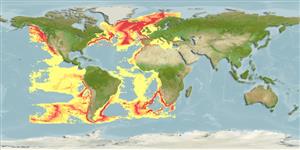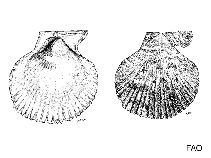Delectopecten vitreus (Gmelin, 1791)
Vitreous scallop| Native range | All suitable habitat | Point map | Year 2050 |

|
| This map was computer-generated and has not yet been reviewed. |
| Delectopecten vitreus AquaMaps Data sources: GBIF OBIS |
Google image | No image available for this species;
drawing shows typical species in Pectinidae.
Classification / Names ชื่อสามัญ | ชื่อพ้อง | CoL | ITIS | WoRMS
Bivalvia | Pectinida | Pectinidae
Environment: milieu / climate zone / ระดับความลึก / distribution range นิเวศวิทยา
เกี่ยวกับหินโสโครก; ระดับความลึก 27 - 4312 m (อ้างอิง 105406). Subtropical; 75°N - 58°S, 145°W - 36°E
Distribution ประเทศต่างๆ | พื้นที่จำแนกตาม FAO | ระบบนิเวศหลายระบบ | การปรากฏขึ้น,การเกิดขึ้น,พบ | การแนะนำ
Eastern Pacific, Atlantic Ocean, Mediterranean Sea to the Arctic: Western to northern Europe, and Western Africa.
Length at first maturity / ขนาด / Weight / Age
วัยเจริญพันธุ์: Lm ? range ? - ? cm Max length : 2.0 cm SHH เพศผู้/กระเทย; (อ้างอิง 90120)
Life cycle and mating behavior วัยเจริญพันธุ์ | การสืบพันธุ์ | การวางไข่ | Eggs | ความดกของไข่ | Larvae
Main reference
อ้างอิง | ผู้ประสานงาน | ผู้ร่วมมือ
Demir, M. 2003 Shells of mollusca collected from the seas of Turkey. Turkey Journal of Zoology 27:101-140. (อ้างอิง 2754)
IUCN Red List Status
(อ้างอิง 130435: Version 2025-1)
CITES status (อ้างอิง 108899)
CMS (อ้างอิง 116361)
Threat to humans
Human uses
| FishSource |
เครื่องมือ
ข้อมูลเพิ่มเติม
Max. ages / sizes
Length-weight rel.
Length-length rel.
Length-frequencies
Mass conversion
อุดมสมบรูณ์
แหล่งที่มาจากอินเตอร์เน็ต
BHL | BOLD Systems | CISTI | DiscoverLife | FAO(Publication : search) | Fishipedia | GenBank (genome, nucleotide) | GloBI | Gomexsi | Google Books | Google Scholar | Google | PubMed | แผนภูมิชีวิตแบบต้นไม้ | Wikipedia (Go, ค้นหา) | บันทึกทางด้านสัตววิทยา



